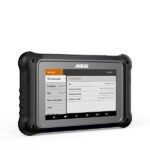Obd2 Emissions systems play a crucial role in maintaining clean air and ensuring your vehicle runs efficiently. This article provides a comprehensive overview of On-Board Diagnostics II (OBD2) and its impact on vehicle emissions. We’ll explore how the system works, why it’s essential, and what you need to know as a vehicle owner.
What is OBD2 and How Does it Monitor Emissions?
OBD2 is a standardized system that monitors your vehicle’s emission control components and overall engine performance. It uses sensors throughout the engine and exhaust system to collect data, which is then analyzed by the vehicle’s onboard computer. When the system detects a problem that could lead to increased emissions, it triggers the “Check Engine” light on your dashboard. This light signals a potential issue impacting obd2 emissions and warrants further investigation. The system stores diagnostic trouble codes (DTCs) that provide specific information about the malfunction, enabling technicians to quickly diagnose and repair the problem.
The Importance of OBD2 for Emissions Control
OBD2 systems are critical for minimizing vehicle emissions and ensuring compliance with environmental regulations. By continuously monitoring key components, OBD2 helps identify issues that can lead to increased pollutants like hydrocarbons, nitrogen oxides, and carbon monoxide. Addressing these issues not only reduces your vehicle’s environmental impact but also often improves fuel efficiency and overall performance. A properly functioning OBD2 system is a vital part of maintaining a vehicle’s optimal operating condition in relation to obd2 emissions.
OBD2 Emissions Testing and Smog Checks
OBD2 plays a central role in vehicle emissions inspections, often referred to as smog checks. During these inspections, technicians use a scan tool to connect to the vehicle’s OBD2 port and retrieve stored DTCs. This data provides insights into the vehicle’s emissions performance and helps determine if it meets regulatory standards. Any stored codes related to obd2 emissions often require repair before the vehicle can pass inspection. Additionally, the readiness monitors within the OBD2 system must indicate that all diagnostic tests have run successfully.
OBD2, Vehicle Maintenance, and Repair
When your “Check Engine” light illuminates, prompt diagnosis and repair are crucial. While not all issues that trigger the light are directly related to obd2 emissions, many can impact both emissions and overall vehicle performance. Utilizing the diagnostic information provided by the OBD2 system, technicians can efficiently pinpoint the source of the problem and implement necessary repairs. Addressing these issues promptly can prevent further damage to your vehicle and help minimize its environmental impact.
Common OBD2 Emission-Related Issues
Several common problems can trigger OBD2 emissions-related DTCs. These include faulty oxygen sensors, malfunctioning catalytic converters, issues with the evaporative emissions system, and problems with the exhaust gas recirculation (EGR) system. Understanding these potential issues and recognizing the symptoms they can produce can help you address problems promptly and maintain your vehicle’s emissions performance.
Aftermarket Parts and Modifications
When replacing parts or modifying your vehicle, it’s essential to ensure compatibility with the OBD2 system. Using non-approved aftermarket parts or making significant modifications can sometimes trigger the “Check Engine” light or even damage the emissions system. Always verify that any aftermarket parts have the necessary certifications and consult with a qualified technician before making substantial modifications.
Beyond OBD2: The Future of Emissions Monitoring
While OBD2 remains the current standard, ongoing research and development are exploring new technologies for emissions monitoring. Concepts like OBD3, which involves wireless transmission of diagnostic data, are being considered for future implementation. These advancements aim to further enhance emissions control and simplify the vehicle inspection process.
Conclusion
OBD2 emissions systems are integral to modern vehicles, ensuring efficient operation and minimizing environmental impact. By understanding how the system works and taking proactive steps to address any issues, vehicle owners can contribute to cleaner air and enjoy optimal vehicle performance.

